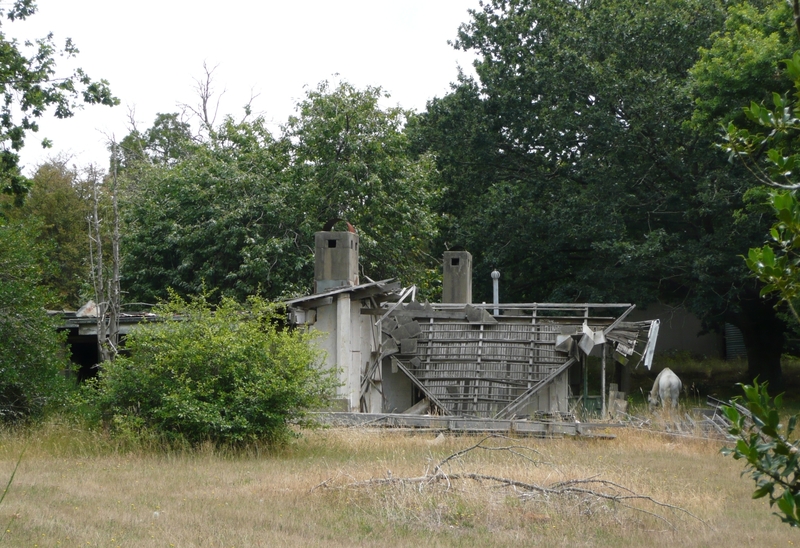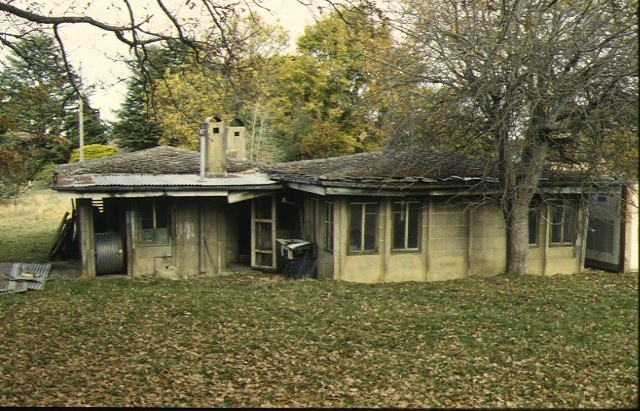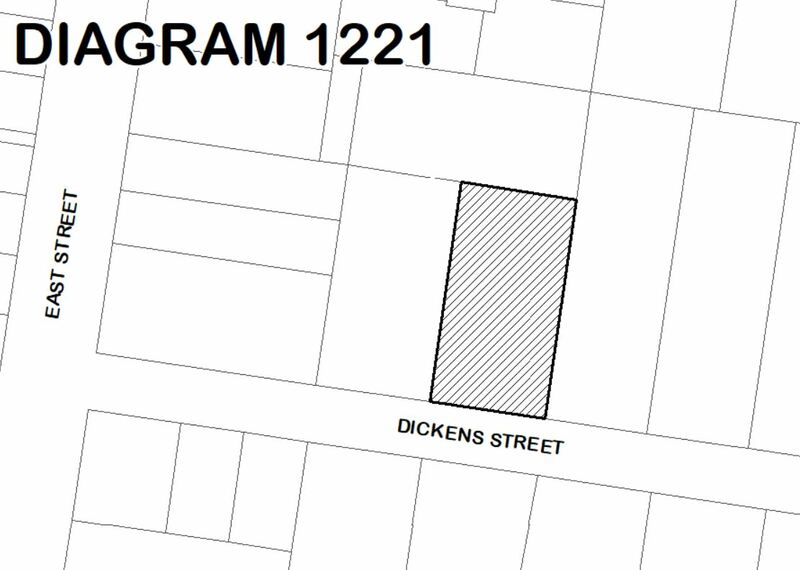FORMER WILLS HOUSE
1 - 3 DICKENS STREET WOODEND, MACEDON RANGES SHIRE
-
Add to tour
You must log in to do that.
-
Share
-
Shortlist place
You must log in to do that.
- Download report




Statement of Significance
The former Wills House, Dickens Street, Woodend, was built in 1923-24 for Alban Henry Wills. The house was designed by architect Walter Burley Griffin using his patented Knitlock concrete blocks.
The Wills House, Dickens Street, Woodend is of architectural, historical and scientific (technical) significance to the State of Victoria.
The Wills House, Dickens Street, Woodend is of architectural significance as an important surviving example of the domestic work undertaken by Walter Burley Griffin using sophisticated geometric planning. It represents a marked contrast to his other realised Knitlock houses, which were typically planned within a single square, cruciform or H-shaped plan. It survives in a ruinous state.
-
-
FORMER WILLS HOUSE - History
The former Wills House, Dickens Street, Woodend, was built in 1923-24 for Alban Henry Wills. The house was designed by architect Walter Burley Griffin using his patented Knitlock concrete blocks. It now stands in a ruinous state.
Griffin was employed by Alban Wills to remodel the interior of his new Collins Street shop in 1919 and then to design a house for his family in Mentone. The latter was based on a modular plan, but not constructed using Griffin's Knitlock system. Griffin was subsequently engaged to design a house for Wills at Woodend, where he utilised the Knitlock construction system.
The Wills family sold the house to John Percy Chirnside, son of the prominent pastoralist Andrew Chirnside, in 1927, and it remained in the ownership of this family until the late 1940s. The house remained in relatively good condition until the 1970s. In 1998 when it suffered considerable storm damage, the house was still largely intact although in poor condition.
The draft statement of significance and the above history were produced as part of an Online Data Upgrade Project 2009. Sources were as follows:
Heritage Alliance, 'Former Alban H Wills Residence, 1 Dickens Street, Woodend, Conservation Options Report', 2005
Contextual History:History of Place:
Architect - Walter Burley Griffin
In the late nineteenth century, Chicago became the epicentre for a new school of architectural thought and practice. Emerging from under the mentorship of architect Louis Sullivan, a group of young architects, many practicing within the confines of Steinway Hall in central Chicago, exchanged and developed ideas through a network which would later become known as the 'Chicago Group'.
Walter Burley Griffin was born in 1876 in Maywood, Illinios and graduated from the University of Illinios at Urbana-Champaign in 1899. After graduation, the young Griffin commenced practice with Dwight H. Perkins and Robert C. Spencer at Steinway Hall and began to develop ideas and concepts linking structures to their environment. Griffin had studied both town-planning and landscape design at university and these teachings became an integral part of his growth as an architect. In 1900, Griffin joined the office of Frank Lloyd-Wright and worked alongside Wright on both joint and individual projects. Marion Mahony, a skilled draughtswoman, also worked in Wright?s office on drafting projects and interior and furnishing designs for Wright. In 1905, Griffin left Wright's practice, apparently disillusioned with Wright's employment conditions and methods of payment, and again practiced at Steinway Hall, however this time in an independent office. The first product of his new practice was Griffin's 'Peters' house in Chicago (1906) which, whilst utilising some of the Wright-inspired concepts of the Prairie School, began to investigate the particular idiom of Griffin's own concepts. Expressions of central bold massing, later to become peculiar to Griffin?s designs, cantilevered eaves and hipped roofs were characteristic of Griffin's work at this time.
Griffin and Mahony married in June 1911 and their union was a combining of 'life and art'. The two had worked on collaborative projects whilst together in Wright's office and this coalition continued throughout their married life. In 1911, Walter and Marion Griffin entered the international competition for Australia?s Federal Capital and when the announcement was made that the Griffin's entry had won, world attention was focused on the Griffins and the Chicago Group. In 1912, William Greg Purcell wrote in the Western Architect, '...Mr Griffin is one of the two or three younger men who have been thoroughly trained for the new movement in architecture ... He has worked hard and stuck uncompromisingly to his ideals in the face of repeated discouragements'. Griffin arrived in Canberra in 1913 and while his first visit lasted no more than three months, he was appointed Federal Capital Director of Design and Construction.
In May 1914, Walter and Marion Griffin arrived in Australia, accompanied by Walter's sister Genevieve and her husband Roy Lippincott, also an architect of the Chicago Group. The Griffins set up offices in both Melbourne and Sydney, although Walter was still intensely involved in the Canberra project. The year following the Griffins' arrival in Australia, G. Taylor, editor of Building ran a series of articles on contemporary architectural principles and theories and Marion contributed with a piece entitled 'Democratic Architecture, Its Developments, Its Principles and Its Ideals'.
In 1920, Griffin terminated his involvement with the Canberra project, having experienced on-going problems with Federal bureaucrats who wanted to seize control of the scheme, and began to focus more on domestic work programs. Griffin had laid out a small estate at Eaglemont in Victoria in 1915 which he had anticipated would provide him with a suitable landscape to plan his own home environment, this later became the site of 'Pholiota'. The Eaglemont project aimed to prove that 'architecture and landscape should be designed together and inhabitants grouped by common interests'.
In 1917, Griffin patented a new concrete block known as knitlock. The knitlock blocks provided an inexpensive construction system which provided unlimited exploration of design, plan and form. In America, Frank Lloyd Wright was also exploring a concrete block system and whilst both architects argued originality, it would appear that an exchange of ideas occurred during the period of invention . Whilst both systems fundamentally explored the same concepts, Griffin's blocks used a panel and pier system and were lighter-weight than Wright's. Griffin declared that the concrete block construction method was cheaper than any other type of construction and believed it to provide a solution to the housing shortage after World War One. He did not believe it be a substitute for timber, brick or stone house , however it provided a viable alternative. The knitlock system also allowed an exploration of organic architectural forms and further applications of the Prairie style first as first developed by Wright.
Griffin's segmental system used two types of blocks, one known as the vertebral and the other the tesseral. The vertebral locked together to form the frame of the structure and the tesseral created the walls. The vertical sections locked together to form pillars, columns, chimneys, ducts, walls, corners, crossings and buttresses. The wall blocks interlocked to form a cellular wall with staggered internal and external joints. The size of the blocks and the lightness of construction allowed span without lintels. Griffin himself wrote: 'Such freedom to deal with the general proportion, making an articulate pile out of the smallest type of building, is the great characteristic of Segmental Architecture'. Griffin's aim with knitlock was to bring quality housing within the reach of the average man and whilst he was the main proponent, other architects also employed the knitlock system; DC Jenkins was responsible for 139 Manning Road in Malvern (1919) and JFW Ballantyne designed 'Stokesay' for Arthur P Onions in Frankston.
The Griffins' own knitlock home, Pholiota was constructed c.1919 and became the prototype for knitlock housing. The floor plan was based on a 3'6" module and the bungalow-style house had a shallow hipped roof. Other knitlock houses by Griffin included the S.R. Salter house in Toorak which was designed 1922-23 and completed in 1924, the Julian S Jefferies House in Surrey Hills Victoria,( 1924) and the two holiday houses at Frankston; Gumnuts and Marnham (demolished), believed to have been used by Walter and Marion as a holiday retreat.
The 'Home of Five Rooms' was developed by Griffin in Melbourne in 1920 and its plan form further articulated some of Griffin's concerns with space and form Set on a small square plan, the house aimed to maximise internal space while interacting harmoniously with its external surrounds.
The Griffins' time in Melbourne also culminated in other significant architectural achievements, including Newman College - Parkville, Capitol House - Melbourne and the Essendon Incinerator complex. In 1921, the Griffins left Melbourne and moved to Castlecrag on Sydney's north shore. Castlecrag was to become one of Griffin's most ambitious projects and was perhaps his definitive statement on architecture inspired by the Australian landscape.
By 1930, Griffin's practice had deteriorated and Griffin himself was suffering depression as a result of his work having been the subject of negative criticism. In 1935, the Griffins designed a scheme for Lucknow University in India and this was accepted soon after. In October 1935 Walter journeyed there to supervise the construction of the university and was later joined by Marion in February 1936 . The Griffins enjoyed a re-birth in India as their arrival was heralded by the press and their ideas more favourably received. Unfortunately this was short-lived as Walter contracted peritonitis and died on 11 February 1937. Marion returned to Australia in 1937, however she departed for America?s mid-west in 1938. Marion Griffin (nee Mahony) died in 1962.
Place - Woodend
The district of Newham and Woodend was first encountered by explorers Hume and Hovell in the 1830s, when they travelled along the eastern side of Victoria's Great Dividing Range. In 1836 Major Mitchell passed through the area as he crossed from Bathurst to Portland and his widely publicised accounts were laudatory in their description of the Woodend region. By 1837 most of the grazing land had been taken up by settlers and it wasn?t until the discovery of gold in the 1850s that Woodend saw a surge of activity. Hotels and unlicensed wine shanties were erected along the tracks to the gold fields and within a short time the township of Woodend was established. Woodend was situated on the track between Melbourne and the Castlemaine and Bendigo digging fields and its name reflects its location: the place where travellers emerged out of the forests of Mount Macedon and into open countryside. On December 3, 1861 the Woodend town site was proclaimed and the Woodend, Newham and Roachford Road Board was created. By the early 20th century, industry in the Woodend region included mixed farming and timber milling, however it was also becoming increasingly popular as an attractive weekend retreat. With the advent of the automobile and an increase in the quality of the roads, more people sought out leisure and a weekend in the country became a popular recreational pursuit. In the early 1920s, the Macedon Ranges Tourist Booklet described the area:
Blessed with a frequent train service, classed as the half way house between Melbourne and Bendigo, glorying in an abundant of water from the crystal springs of Macedon and graced by man's best handiwork in splendour of leaf and flower, Woodend's claim to being 'the healthiest town in Victoria' cannot be gainsaid. Golf, bowls, tennis, croquet, swimming, fishing, hooting, here are pleasures and pastimes for all ...'
For Woodend, a new industry and a change in profile resulted in the erection of a new type of dwelling, that of the weekend holiday house.
History of Place:
Alban Wills, a partner in the Wills and Paton Edison Phonographic Agency, commissioned Walter Burley Griffin to design a house for his family c. 1918. Griffin had re-modelled Wills' shop in Collins Street (now the site of the Sportsgirl Centre) earlier and one can only assume that Wills was pleased with Griffin's work. Both Wills and Paton had a business relationship with Griffin as shareholders in the Griffin and O'Malley sub-division at Montmorency and streets were named after both men. Until 1918-19, the Wills family had been renting a house in Kew and Griffin?s quality low-cost housing proposal must have seemed an inviting proposition. The c.1918 house was built at Mentone and was designed by Griffin and his brother-in-law, Roy Lippincott. The house, ( now demolished) is described as having had a timber frame with fibro-cement cladding and a roof with a large over-hang.
Mabel M Wills, the wife of Alban, purchased lots 17 and 18 of Crown Allotment Ninety Eight in the Parish of Woodend in the early 1920s. The land, formerly part of the Mount View Estate had been owned by John F Gilchrist prior to the acquisition by Mrs Wills. The Wills again engaged Griffin and the Woodend house was constructed on lot 18 c.1922 . Mrs Wills purchased lot 19 shortly after the construction of the holiday house and all three lots were consolidated into one title in 1927. Griffin designed the Woodend house on his own, evidently due to a quarrel with Lippincott , and the knitlock blocks were cast on the site. The Wills owned the Woodend property until 1949, when it was sold to William Joseph Redmond, a grocer of Woodend.
Associated People: Owner AH WILLS;FORMER WILLS HOUSE - Permit Exemptions
General Exemptions:
General exemptions apply to all places and objects included in the Victorian Heritage Register (VHR). General exemptions have been designed to allow everyday activities, maintenance and changes to your property, which don’t harm its cultural heritage significance, to proceed without the need to obtain approvals under the Heritage Act 2017.
Places of worship: In some circumstances, you can alter a place of worship to accommodate religious practices without a permit, but you must notify the Executive Director of Heritage Victoria before you start the works or activities at least 20 business days before the works or activities are to commence.
Subdivision/consolidation: Permit exemptions exist for some subdivisions and consolidations. If the subdivision or consolidation is in accordance with a planning permit granted under Part 4 of the Planning and Environment Act 1987 and the application for the planning permit was referred to the Executive Director of Heritage Victoria as a determining referral authority, a permit is not required.
Specific exemptions may also apply to your registered place or object. If applicable, these are listed below. Specific exemptions are tailored to the conservation and management needs of an individual registered place or object and set out works and activities that are exempt from the requirements of a permit. Specific exemptions prevail if they conflict with general exemptions.
Find out more about heritage permit exemptions here.
Specific Exemptions:
General Conditions: 1. All exempted alterations are to be planned and carried out in a manner which prevents damage to the fabric of the registered place or object. General Conditions: 2. Should it become apparent during further inspection or the carrying out of works that original or previously hidden or inaccessible details of the place or object are revealed which relate to the significance of the place or object, then the exemption covering such works shall cease and Heritage Victoria shall be notified as soon as possible. Note: All archaeological places have the potential to contain significant sub-surface artefacts and other remains. In most cases it will be necessary to obtain approval from the Executive Director, Heritage Victoria before the undertaking any works that have a significant sub-surface component.
General Conditions: 3. If there is a conservation policy and planall works shall be in accordance with it. Note:A Conservation Management Plan or a Heritage Action Planprovides guidance for the management of the heritage values associated with the site. It may not be necessary to obtain a heritage permit for certain works specified in the management plan.
General Conditions: 4. Nothing in this determination prevents the Executive Director from amending or rescinding all or any of the permit exemptions. General Conditions: 5. Nothing in this determination exempts owners or their agents from the responsibility to seek relevant planning or building permits from the responsible authorities where applicable. Minor Works : Note: Any Minor Works that in the opinion of the Executive Director will not adversely affect the heritage significance of the place may be exempt from the permit requirements of the Heritage Act. A person proposing to undertake minor works must submit a proposal to the Executive Director. If the Executive Director is satisfied that the proposed works will not adversely affect the heritage values of the site, the applicant may be exempted from the requirement to obtain a heritage permit. If an applicant is uncertain whether a heritage permit is required, it is recommended that the permits co-ordinator be contacted.
-
-
-
-
-
WOODEND SHELTER SHED
 Victorian Heritage Inventory
Victorian Heritage Inventory -
Former Wills House
 National Trust H1221
National Trust H1221 -
Eucalyptus aggregata
 National Trust
National Trust
-
"1890"
 Yarra City
Yarra City -
"AMF Officers" Shed
 Moorabool Shire
Moorabool Shire -
"AQUA PROFONDA" SIGN, FITZROY POOL
 Victorian Heritage Register H1687
Victorian Heritage Register H1687
-
10 Down Street
 Yarra City
Yarra City
-
-















